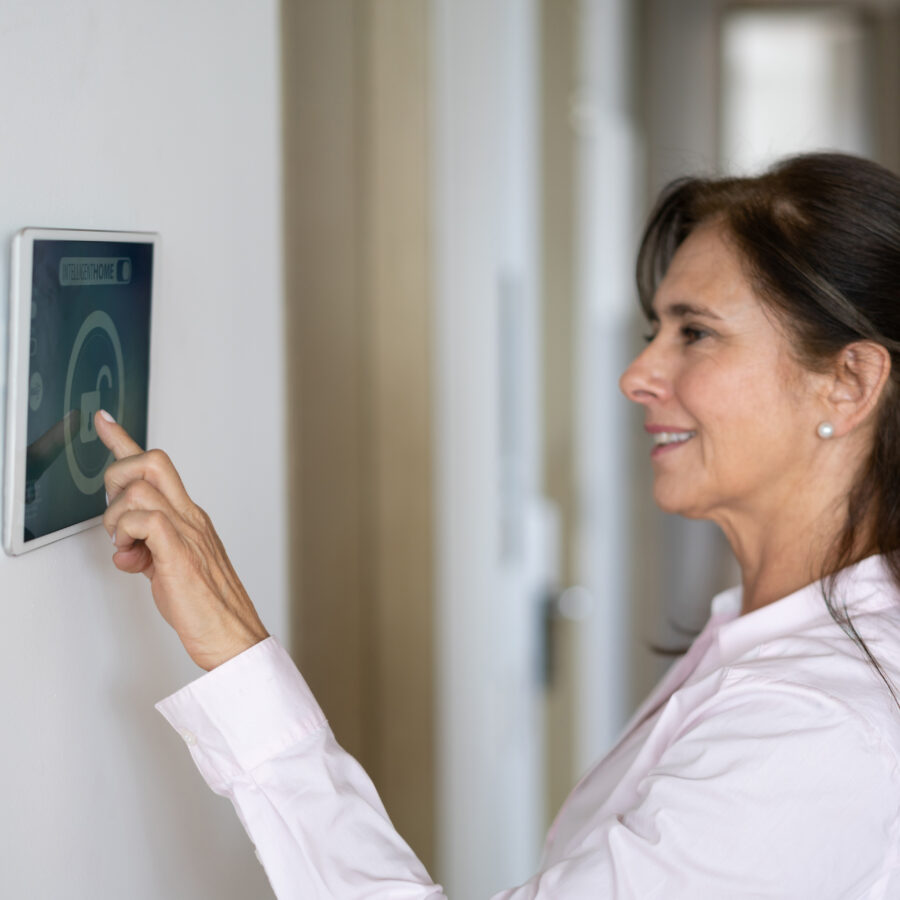In-home devices that utilize “smart” technology can help aging adults stay in their homes longer and make life safer and more convenient. For family members who can’t be in the home as much as they would like, the devices allow the family to monitor, be aware, and even help regulate what is happening in their loved one’s home.
Choosing the Right Technology
The field of smart home technology is rapidly growing, which makes it challenging to find the devices appropriate for your loved one.
Some seniors are quite knowledgeable on the subject of smart technology and smart devices. For those who are, they should be consulted on which devices to place in their home and their purpose. No technology, however smart, is worth anything if it is unnecessary, unused, or disliked by the senior.
Tips on Setup
Most smart devices have a companion app that allows setup and the ability to manage the device remotely. These require a Wi-Fi connection, and the senior’s home should have sufficient bandwidth if multiple devices or devices that stream video are being used.
If you do plan on several devices working together, be sure they support the same smart-home software platforms. Most smart devices are simple to set up (using a smartphone), able to send notifications and, in many cases, provide remote access control.
Security Systems
There are do-it-yourself home security systems with several capabilities and options:
- Sensors that detect when a door or window has been left open
- Cameras
- Smoke detectors
- Motion sensors
- Water sensors
- Glass break sensors
One example of a do-it-yourself system is the Ring Alarm 5-Piece Kit. The Ring Premium Home Plan is an example of a professional monitoring plan, which offers access to a live person at a call center 24/7, who will react to needs and emergencies. (An ideal option when family members cannot cover every hour of the day and night.)
If a complete security system is not needed, you can pick and choose from several options:
Lights and thermostat controls
Thermostats can be run on personalized, automated systems. They can also be voice- or remotely controlled and monitored from a distance.
Smart smoke detectors
When smoke or carbon monoxide is detected, these devices sound a loud voice alert that lets occupants know what room the threat is in. The detectors also send smartphone alerts to family, friends or neighbors. An example would be the Google Nest.
Emergency contact systems
These systems have become more sophisticated over the years. Some can detect falls and certain types of cardiac arrest, and can call for help automatically.
Communication devices
The Amazon Echo Dot allows anyone to control it by making verbal commands. Though it does not connect to 911, it can connect to family, friends and caregivers. The Echo Show is a smart speaker with a built-in screen and camera. Alexa on the Echo Show can be used to schedule reminders about appointments and medication doses.
Medication managers
Other devices can be programmed to let seniors know when it is time to take medications, and provide notifications about physician checkups and appointments.
Digital pill dispensers such as MedMinder dispense medications to seniors. A caregiver fills the medicine tray and can remotely schedule when medications are to be taken. The device unlocks according to the schedule to make the medications available, and beeps if they have not been taken. The family caregiver is notified as well.
“Reminder Rosie” is a talking clock that can be programmed to remind seniors to take their medication via a prerecorded voice message from a caregiver. Personal messages can also be recorded with other reminders, such as “it’s time to exercise.”
Telemedicine Services
Telemedicine enables health care providers to remotely deliver clinical health services and information to patients via interactive and video telecommunications through devices like smartphones, tablets, home computers or laptops. The connection between patients and care providers is through a program, app or website with video and audio capabilities.
Leak detection sensors
Smart sensors that detect water leaks can be placed in areas where they are likely: hot water heater, tub, sinks, etc. When water is detected, a loud alarm sounds and smartphone alerts are sent.
Video doorbells
These devices allow video screening of anyone who comes to your loved one’s door. The notification will be delivered to the senior and to a family member via smartphone.
Smart plugs
A smart plug is controlled by an app and lets a person turn on and off any appliance that plugs into a standard wall socket. This can help if you wonder whether or not your loved one has turned off an appliance, or has forgotten to leave a lamp on to guide them during the night. They can also be activated by voice command so that seniors can control them without leaving a chair or bed. Smart plugs can be put on a schedule to come on at certain times or be paired with a motion sensor to light up a dark hallway.
Smart refrigerators
Some models provide alerts if the refrigerator door has been left open. Along with this alert, family member’s smartphones can also receive temperature change notifications. The family member can send and receive notes and make calendar entries that appear on the fridge’s screen. Here is a review of some models.
Smart stoves
With the iGuardStove, a monitor detects motion (or lack thereof) in the kitchen and can identify if the stove is on or not. If no movement is detected in the kitchen for a set period of time, the stove is shut off.
Discover more senior home safety tips on Bethesda’s blog.
Back to All Posts


